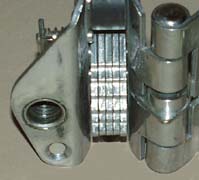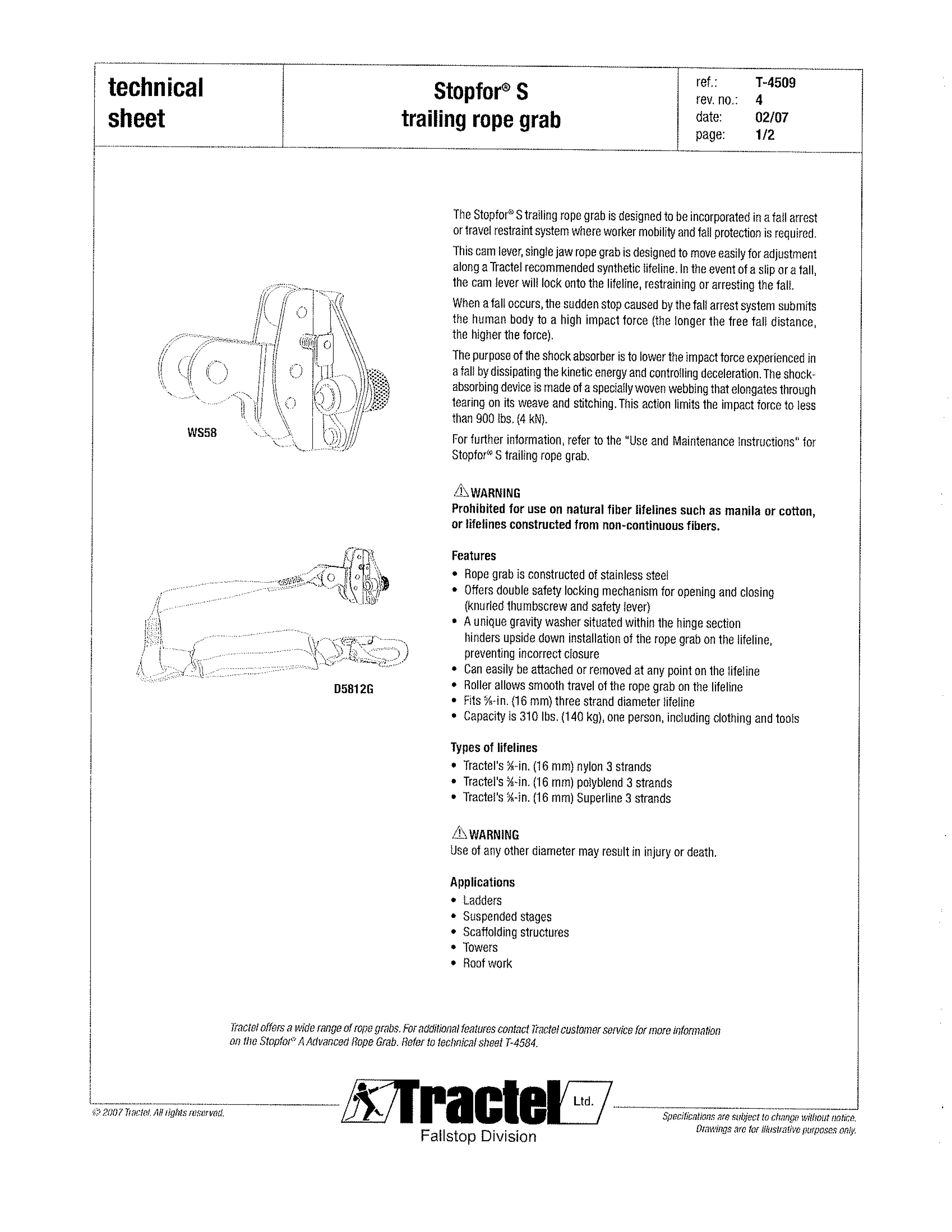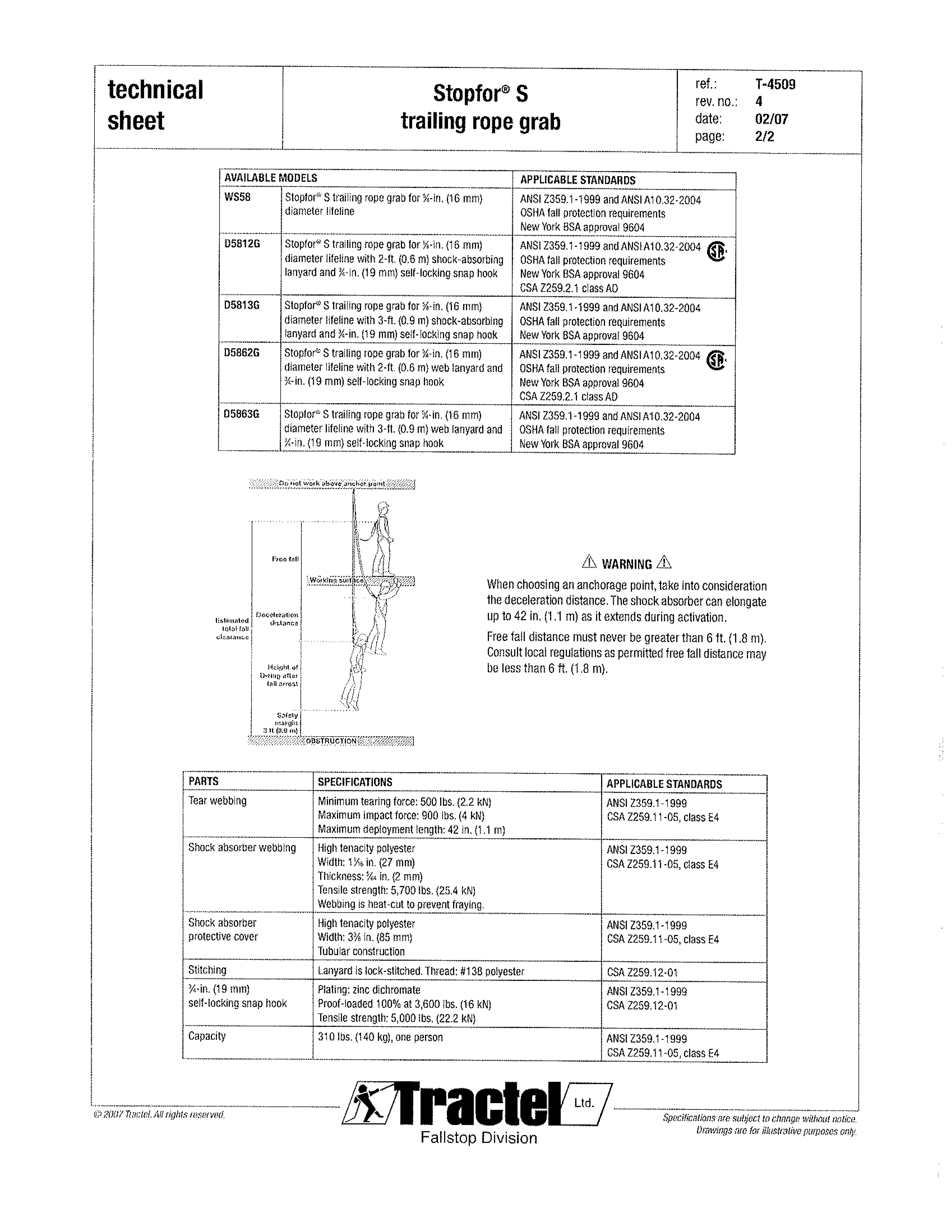Overview
[ Top
| Stopfor D
| Stopfor S
| Return to Rope Grabs
]
Stopfor A
(#1709)
Technical Details
I acquired my Tractel Stopfor A from Magen Deans in 2010.
My Tractel Stopfor A is 120 mm. long, 106 mm. wide, 71 mm. high, and weighs 745 g.
The Stopfor A is made of stamped steel like the Komet and Miller rope grabs. It operates
on the same principle as a Type
1 Lever Cam Ascender. The cam is made of 5 pieces of sheet
steel riveted together. Each plate has four asymmetrical notches forming four Z-shaped teeth. The frame opens to accept the rope. The frame is hinged, and a threaded
knob that secures the back of the frame when it is closed. A spring-loaded
lever engages a groove in the knob’s bolt, keeping it from opening.
One must depress the lever to open the Tractel-Stop. The closure
bolt has a tapered end, so there is no need to depress the lever
to close the device. A lightweight steel piece
slides on the hinge pin. When the device is right-side-up,
an ear clears a notch in the rear channel, allowing it to open
easily. When the device is inverted, gravity pulls it out of alignment
with the notch.
The Stopfor A has a hard plastic roller above the cam. This
reduces friction in the same way as the rollers on the Komet rope grabs or the Lewis ascender.
The outside back plate on my Stopfor S is stamped
with an up-pointing arrow and "HAUT,"
"UP, "OBEN," and "ALTO" near the knob and the following over the rope channel:
Tractel Stopfor A Class ADP Cap 310 lbs
WARNING: Use only with 5/8" (16 mm.) dia Tractel
specified synthetic rope with arrow pointing up
Made in France.
The inside of the back plate is stamped with an up-pointing arrow and "HAUT,"
"UP, and ’Ø5/8"’
One side is stamped with the following:
Do not use unless
properly trained.
Before use read,
understand, and follow
all manufacturer
instructions SA Z259.2.1
ANSI Z359.1 Type 1
Patent pending
One side of the attachment arm is stamped
"CONNECT D.L. SNAP HOOK TO PIN ONLY" and "ENSURE
THERE IS NO GAP BETWEEN SIDE PLATES" on the right and "1002056"
on the left.
Unfortunately, a mild shake is all one needs to
override the gravity lock. My personal preference for safety is to rely
on doing things right rather than on gadgetry.
[ Top
| Stopfor A
| Stopfor S
| Return to Rope Grabs
]
Stopfor D
(#874)
Technical Details
I acquired my Tractel-Stopfor D from Richard Wolle in 2007.
The Tractel Stopfor D operates on the same principle as a Type 1 Lever Cam Ascender.
The shell is a moderately complex steel casting with double side
walls. The inner wall has inclined slots to hold the cam axle.
The cam is made of 5 pieces of sheet steel riveted together, and
the cam face is smooth. The Tractel-Stop has a hard plastic roller
above the cam. This reduces friction in the same way as the rollers
on the Komet rope grabs or the
Lewis
ascender. The roller is mounted in a cam-holder made from two
pieces of sheet steel, riveted together.
The cam opens to accept the rope, but does so in a strange
and most awkward manner. The cam axle slides in a slot in the
cam holder. A spring-loaded pin forces the cam axle downward,
and a latch on the front of the cam holds the axle in place when
the grab is closed. The latch that holds the cam down is held
closed by a spring-loaded pin.
The front side of the frame has raised cast markings saying
"Drise," "Ø 11," "Kernmantle,"
"rope," "353-2," and "0082." The
front side of the frame has raised cast markings with the Tractel
logo, "Stopfor D," "Red 0621150," "Made
in," and "France." This side is etched with "Capacity
310lbs," a CSA mark, "Z259.2.1 class A0," and "ANSI
Z359.1 Type 1." The spine is etched with "Use only with
kernmantle rope 7/16"-1/2" dia.," "Do not
use unless properly trained. Before use read," "understand
and follow all manufacturer instructions," and "Part
number W0 12." The cam holder is stamped with an up arrow
labeled with "UP," HAUT," "OBEN," and
"ALTO."
To open the device, press the pin on the side, rotate the latch
lever, lift the cam against the spring in the cam holder while
pulling outward to keep the cam axle riding in its slots, and
then swing the cam open. The bizarre mechanism makes this a two-handed
job, I've consistently failed to open it easily with one hand.
Closing it is almost as bad. I don't have the patience to put
up with this mechanism; neither should you.
[ Top
| Stopfor A
| Stopfor D
| Return to Rope Grabs
]
Stopfor S
(#766)
Technical Details
 I acquired
my Tractel-Stop used from Jame Bullard in January 2002.
I acquired
my Tractel-Stop used from Jame Bullard in January 2002.
The Tractel-Stop is made of stamped steel like the Komet
and Miller rope grabs. It operates
on the same principle as a Type
1 Lever Cam Ascender. The cam is made of 5 pieces of sheet
steel riveted together, providing an unusual tooth pattern (at
least for an ascender). The more interesting feature is how the
frame opens to accept the rope. The frame is hinged, and a threaded
knob that secures the back of the frame when it is closed. A spring-loaded
lever engages a groove in the knob’s bolt, keeping it from opening.
One must depress the lever to open the Tractel-Stop. The closure
bolt has a tapered end, so there is no need to depress the lever
to close the device.
The Tractel-Stop has a hard plastic roller above the cam. This
reduces friction in the same way as the rollers on the Komet
rope grabs or the Lewis
ascender.
The back of my Stopfor S is stamped
with the following:
Tractel Stopfor S Cap 310 lbs
WARNING: Use only with 5/8" (16 mm.) dia
Synthetic rope with arrow pointing up
Do not use unless properly trained Before use read,
understand, and follow all manufacturers instructions.
Made in France.
Other markings include an up-pointing arrow and "HAUT,"
"UP, "OBEN," and "ALTO" near the knob,
the same arrow and words inside the rope channel, and on the cam,
"CONNECT D.L.SNAP HOOK TO PIN ONLY" and "ENSURE
THERE IS NO GAP BETWEEN SIDE PLATES" on the right and "9712238"
on the left.
In March 2008, Christer Hogne sent me some additional information,
including a technical sheet from Tractel Ltd. Fallstop Division.
Christer wrote the following:
I believe that you have
insufficient information on that particular rope grab…. One
of the key features of this particular rope grab is the gravity
lock. If the rope grab is not in the upright position, it will
not close. This helps prevent untrained user’s from making fatal
errors.
The gravity lock is a lightweight steel piece
that slides on the hinge pin. When the device is right-side-up,
an ear clears a notch in the rear channel, allowing it to open
easily. When the device is inverted, gravity pulls it out of alignment
with the notch. Unfortunately, a mild shake is all one needs to
realign the pin. Once again, my personal preference is to rely
on doing things right rather than on gadgetry for safety.
[ Top
| Stopfor A
| Stopfor D
| Stopfor S
]




